介词加关系代词(定从).
- 格式:pdf
- 大小:4.11 MB
- 文档页数:28
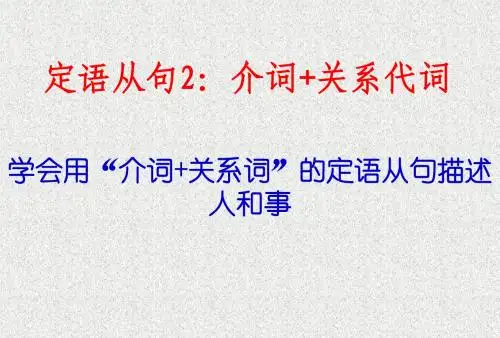
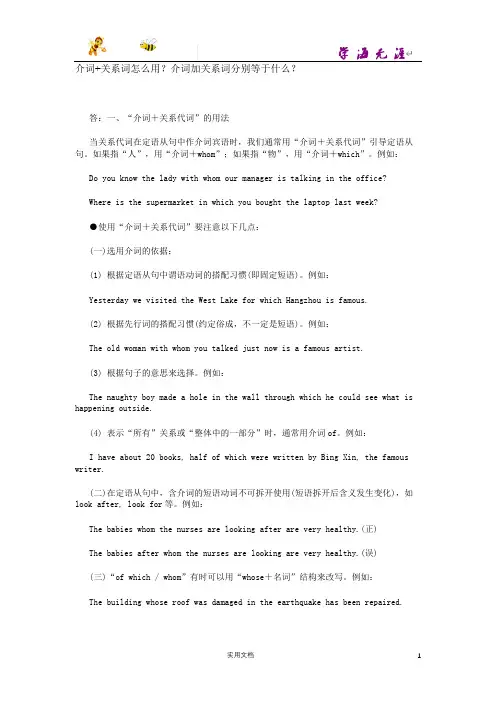
介词+关系词怎么用?介词加关系词分别等于什么?答:一、“介词+关系代词”的用法当关系代词在定语从句中作介词宾语时,我们通常用“介词+关系代词”引导定语从句。
如果指“人”,用“介词+whom”;如果指“物”,用“介词+which”。
例如:Do you know the lady with whom our manager is talking in the office?Where is the supermarket in which you bought the laptop last week?●使用“介词+关系代词”要注意以下几点:(一)选用介词的依据:(1) 根据定语从句中谓语动词的搭配习惯(即固定短语)。
例如:Yesterday we visited the West Lake for which Hangzhou is famous.(2) 根据先行词的搭配习惯(约定俗成,不一定是短语)。
例如:The old woman with whom you talked just now is a famous artist.(3) 根据句子的意思来选择。
例如:The naughty boy made a hole in the wall through which he could see what is happening outside.(4) 表示“所有”关系或“整体中的一部分”时,通常用介词of。
例如:I have about 20 books, half of which were written by Bing Xin, the famous writer.(二)在定语从句中,含介词的短语动词不可拆开使用(短语拆开后含义发生变化),如look after, look for等。
例如:The babies whom the nurses are looking after are very healthy.(正)The babies after whom the nurses are looking are very healthy.(误)(三)“of which / whom”有时可以用“whose+名词”结构来改写。
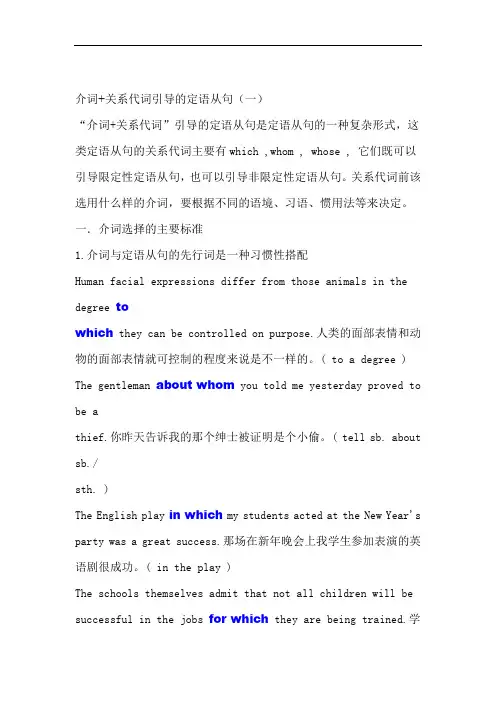
介词+关系代词引导的定语从句(一)“介词+关系代词”引导的定语从句是定语从句的一种复杂形式,这类定语从句的关系代词主要有which ,whom , whose , 它们既可以引导限定性定语从句,也可以引导非限定性定语从句。
关系代词前该选用什么样的介词,要根据不同的语境、习语、惯用法等来决定。
一.介词选择的主要标准1.介词与定语从句的先行词是一种习惯性搭配Human facial expressions differ from those animals in the degree towhich they can be controlled on purpose.人类的面部表情和动物的面部表情就可控制的程度来说是不一样的。
( to a degree ) The gentleman about whom you told me yesterday proved to be athief.你昨天告诉我的那个绅士被证明是个小偷。
( tell sb. about sb./sth. )The English play in which my students acted at the New Year's party was a great success.那场在新年晚会上我学生参加表演的英语剧很成功。
( in the play )The schools themselves admit that not all children will be successful in the jobs for which they are being trained.学校本身承认,并不是所有的孩子都能在他们所接受的培训的职业成功。
( be trainedfor the job )2.介词与定语从句中的动词是一种习惯性搭配Who is the man with whom our teacher is shaking hands? 我们的老师与之握手的那个男士是谁? ( shake hands with sb. ) Last month , part of Southeast Asia was struck by floods , from上个月,东南亚的部分 effects the people are still suffering. whose地区发生洪水,人们还在遭受着洪水所带来的影响。
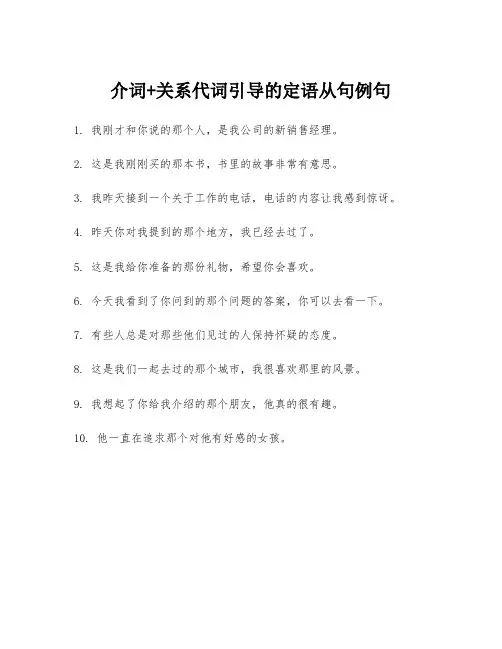
介词+关系代词引导的定语从句例句
1. 我刚才和你说的那个人,是我公司的新销售经理。
2. 这是我刚刚买的那本书,书里的故事非常有意思。
3. 我昨天接到一个关于工作的电话,电话的内容让我感到惊讶。
4. 昨天你对我提到的那个地方,我已经去过了。
5. 这是我给你准备的那份礼物,希望你会喜欢。
6. 今天我看到了你问到的那个问题的答案,你可以去看一下。
7. 有些人总是对那些他们见过的人保持怀疑的态度。
8. 这是我们一起去过的那个城市,我很喜欢那里的风景。
9. 我想起了你给我介绍的那个朋友,他真的很有趣。
10. 他一直在追求那个对他有好感的女孩。

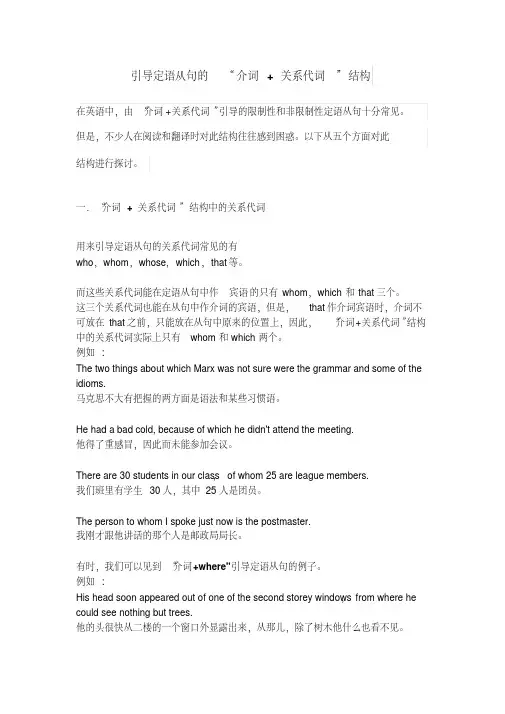
引导定语从句的“ 介词+ 关系代词” 结构在英语中,由“介词+关系代词”引导的限制性和非限制性定语从句十分常见。
但是,不少人在阅读和翻译时对此结构往往感到困惑。
以下从五个方面对此结构进行探讨。
一.“介词+ 关系代词” 结构中的关系代词用来引导定语从句的关系代词常见的有who,whom,whose,which,that等。
而这些关系代词能在定语从句中作宾语的只有whom,which和that三个。
这三个关系代词也能在从句中作介词的宾语,但是,that作介词宾语时,介词不可放在that之前,只能放在从句中原来的位置上,因此,“介词+关系代词”结构中的关系代词实际上只有whom和which两个。
例如:The two things about which Marx was not sure were the grammar and some of the idioms.马克思不大有把握的两方面是语法和某些习惯语。
He had a bad cold, because of which he didn't attend the meeting.他得了重感冒,因此而未能参加会议。
There are 30 students in our class,of whom 25 are league members.我们班里有学生30人,其中25人是团员。
The person to whom I spoke just now is the postmaster.我刚才跟他讲话的那个人是邮政局局长。
有时,我们可以见到“介词+where"引导定语从句的例子。
例如:,from where he His head soon appeared out of one of the second storey windowscould see nothing but trees.他的头很快从二楼的一个窗口外显露出来,从那儿,除了树木他什么也看不见。
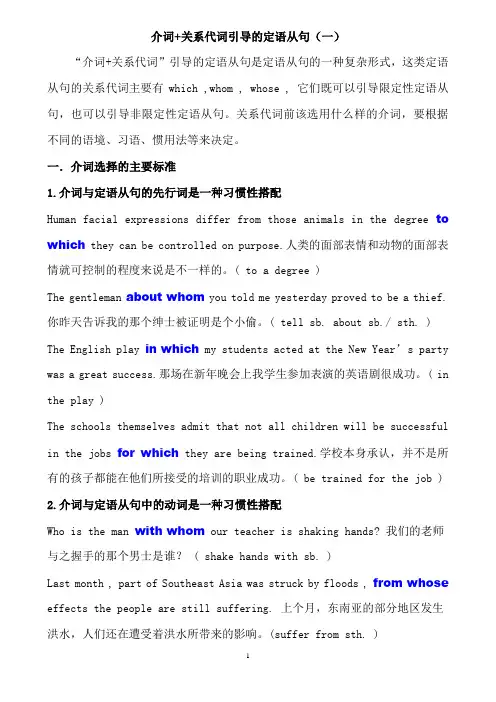
介词+关系代词引导的定语从句(一)“介词+关系代词”引导的定语从句是定语从句的一种复杂形式,这类定语从句的关系代词主要有which ,whom , whose , 它们既可以引导限定性定语从句,也可以引导非限定性定语从句。
关系代词前该选用什么样的介词,要根据不同的语境、习语、惯用法等来决定。
一.介词选择的主要标准1.介词与定语从句的先行词是一种习惯性搭配Human facial expressions differ from those animals in the degree to which they can be controlled on purpose.人类的面部表情和动物的面部表情就可控制的程度来说是不一样的。
( to a degree )The gentleman about whom you told me yesterday proved to be a thief.你昨天告诉我的那个绅士被证明是个小偷。
( tell sb. about sb./ sth. ) The English play in which my students acted at the New Year’s party was a great success.那场在新年晚会上我学生参加表演的英语剧很成功。
( in the play )The schools themselves admit that not all children will be successful in the jobs for which they are being trained.学校本身承认,并不是所有的孩子都能在他们所接受的培训的职业成功。
( be trained for the job ) 2.介词与定语从句中的动词是一种习惯性搭配Who is the man with whom our teacher is shaking hands? 我们的老师与之握手的那个男士是谁? ( shake hands with sb. )Last month , part of Southeast Asia was struck by floods , from whose effects the people are still suffering. 上个月,东南亚的部分地区发生洪水,人们还在遭受着洪水所带来的影响。


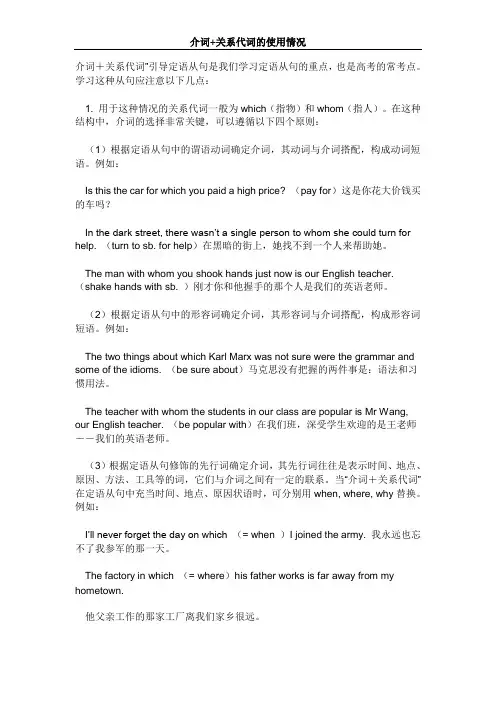
介词+关系代词”引导定语从句是我们学习定语从句的重点,也是高考的常考点。
学习这种从句应注意以下几点:1. 用于这种情况的关系代词一般为which(指物)和whom(指人)。
在这种结构中,介词的选择非常关键,可以遵循以下四个原则:(1)根据定语从句中的谓语动词确定介词,其动词与介词搭配,构成动词短语。
例如:Is this the car for which you paid a high price? (pay for)这是你花大价钱买的车吗?I n the dark street, there wasn’t a single person to whom she could turn for help. (turn to sb. for help)在黑暗的街上,她找不到一个人来帮助她。
The man with whom you shook hands just now is our English teacher. (shake hands with sb. )刚才你和他握手的那个人是我们的英语老师。
(2)根据定语从句中的形容词确定介词,其形容词与介词搭配,构成形容词短语。
例如:The two things about which Karl Marx was not sure were the grammar and some of the idioms. (be sure about)马克思没有把握的两件事是:语法和习惯用法。
The teacher with whom the students in our class are popular is Mr Wang, our English teacher. (be popular with)在我们班,深受学生欢迎的是王老师--我们的英语老师。
(3)根据定语从句修饰的先行词确定介词,其先行词往往是表示时间、地点、原因、方法、工具等的词,它们与介词之间有一定的联系。
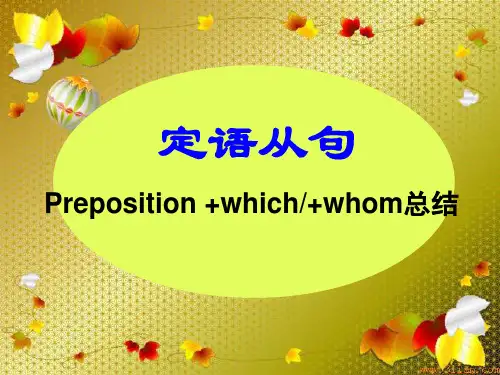
介词后面定语从句介词后面定语从句英语最早被中世纪的英国使用,并因其广阔的殖民地而成为世界使用面积最广的语言。
下面是店铺为大家整理的介词后面定语从句,欢迎阅读与收藏。
1.由“介词+关系代词”引导的定语从句主要用于正式文体,在非正式文体中通常将介词放至句末。
如:This is the man to whom I referred. 我指的就是这个人。
This is the man (whom) I referred to. 我指的就是这个人。
2. 直接用于介词后作宾语的关系代词which不能换成that,直接用于介词后作宾语的关系代词whom不能换成who:介词用于句末,则用作宾语的which, whom也可换成that, who,或者省略不同。
如:这是一个我们讨论了许多的问题。
This is a subject about which we have talked a lot.(which不能换成that,也不能省略)This is a subject which we have talked about a lot. 这是一个我们讨论了许多的`问题。
(which可以换成that,也可以省略)3. 关系副词when, where, why根据情况有时可换成“介词+关系代词which”。
如: That is the day when [=on which] he was born. 那就是他出生的日子。
That is the house where [=in which] he lived. 那就是他住过的房子。
That is the reason why [=for which] he must apologize. 那就是他必须道歉的原因。
4. 在很正式的文体中,“介词+关系代词”引导的定语从句可紧缩成“介词+关系代词+不定式”结构。
如:在那儿孩子们有个玩耍的花园。
正:There the children had a garden in which to play. (很正式)正:There the children had a garden in which they could play. (较正式)正:There the children had a garden to play in. (较口语化)注:这类“介词+关系代词++不定式”结构中的介词不能没有,也不能放在句末。
介词+关系代词“介词+关系代词"引导的定语从句是定语从句的一种复杂形式,这类定语从句的关系代词主要有which ,whom , whose , 它们既可以引导限定性定语从句,也可以引导非限定性定语从句.关系代词前该选用什么样的介词,要根据不同的语境、习语、惯用法等来决定。
一.介词选择的主要标准1.介词与定语从句的先行词是一种习惯性搭配Human facial expressions differ from those animals in the degree to which they can be controlled on purpose.人类的面部表情和动物的面部表情就可控制的程度来说是不一样的。
( to a degree )The gentleman about whom you told me yesterday proved to be a thief.你昨天告诉我的那个绅士被证明是个小偷。
( tell sb. about sb./ sth. )The English play in which my students acted at the New Year’s party was a great success。
那场在新年晚会上我学生参加表演的英语剧很成功。
( in the play )The schools themselves admit that not all children will be successful in the jobs for which they are being trained.学校本身承认,并不是所有的孩子都能在他们所接受的培训的职业成功.( be trained for the job )2.介词与定语从句中的动词是一种习惯性搭配Who is the man with whom our teacher is shaking hands?我们的老师与之握手的那个男士是谁? ( shake hands with sb. )Last month , part of Southeast Asia was struck by floods ,from whose effects the people are still suffering。
介词加whom定语从句
定语从句是由关系代词"whom"引导的,用来修饰先行词。
whom在定语从句中作为宾语出现,常常与介词搭配使用。
以下是一些例子:
1. The woman to whom he was speaking is my mother. (他正在与那位女士交谈,她是我的母亲。
)
2. The professor for whom I have great respect is retiring. (我非常尊敬的教授即将退休。
)
3. We met a couple with whom we had dinner last night. (我们昨晚与他们一起吃过晚饭的那对夫妇我们又见到了。
)
4. The company by whom he was employed went bankrupt. (雇佣他的那家公司破产了。
)
5. Is there anyone to whom I should address my concerns? (有人我需要向他们表达我的关切吗?)
需要注意的是,定语从句中的介词+whom可以放到句子末尾,即whom+介词的形式。
例如:The woman whom he was speaking to is my mother. (这个句子与第一句的意思相同)。